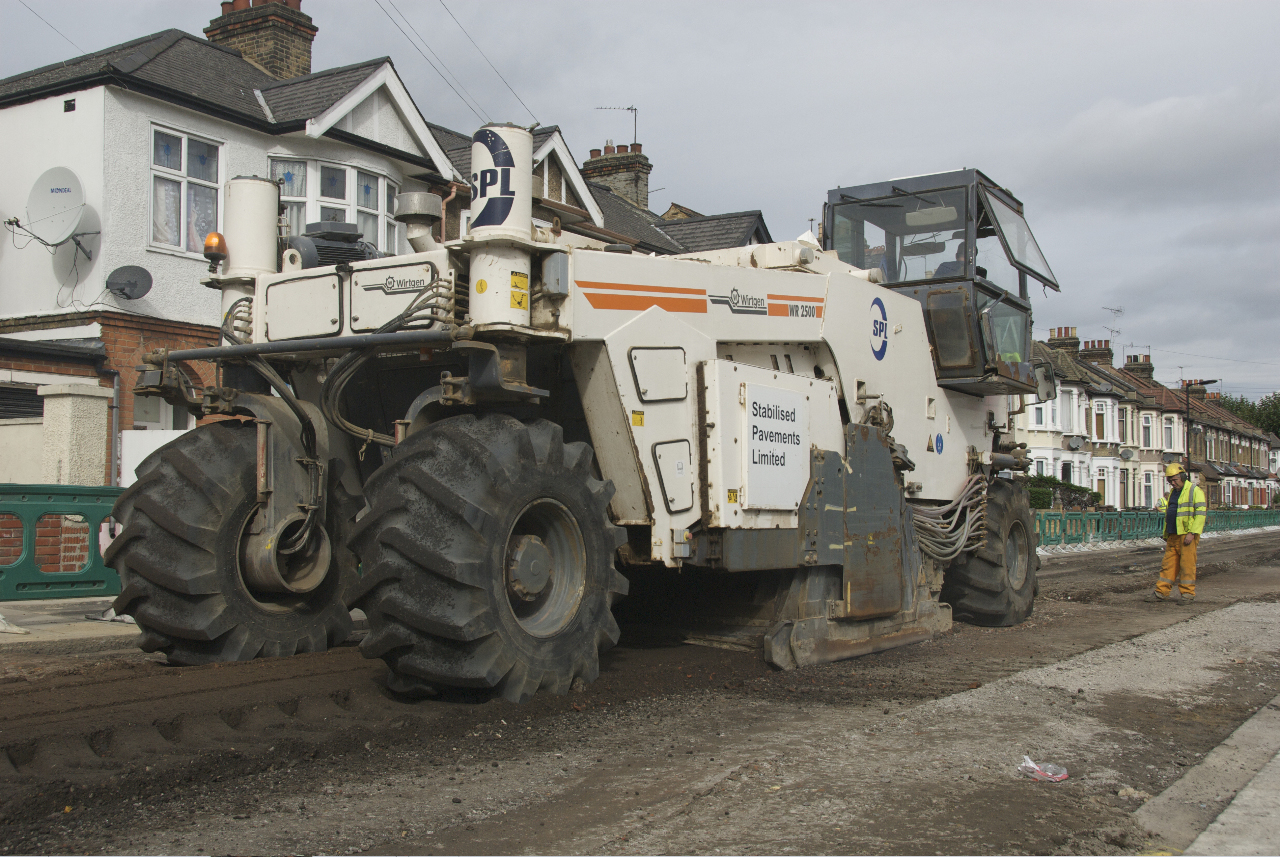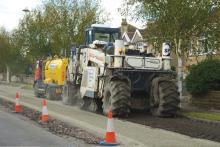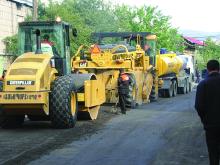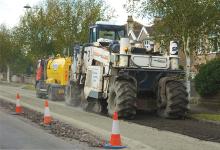Recycling is a key issue for asphalt road construction, with many technologies now coming to market. Bith an ever increasing emphasis on sustainability forcing change in the construction sector in Europe and North America, the highway sector now has to seek new solutions.

For the in-situ recycling in Newham SPL used its 500kW Wirtgen WR2500 Recycler pulverising the damaged road pavement to the required depth of 250mm
Recycling is a key issue for asphalt road construction, with many technologies now coming to market
Bith an ever increasing emphasis on sustainability forcing change in the construction sector in Europe and North America, the highway sector now has to seek new solutions. For asphalt road construction, recycling of road materials offers significant benefits in terms of reduced emissions and costs, with many new technologies now coming to market.A new research project in the UK is offering the potential to realise significant carbon savings.
An industry group, funded by investment from the Carbon Trust under the Industrial Energy Efficiency Accelerator (IEEA), has embarked on a two-year research initiative to develop a unique approach for more sustainable asphalt production. Led by
The group is working on designing, testing and demonstrating the viability of semi-warm and cold-temperature asphalt as an alternative to conventional hot-mix asphalt. The goal is to save energy in the asphalt production process, and reduce the carbon footprint of roads, by developing more carbon-efficient technology and new specifications.
Research conducted by the Carbon Trust has identified that the energy used to dry aggregates in existing hot mix production processes currently contributes 20% of the carbon generated by the aggregates sector. Presently, asphalt in the UK is produced at temperatures ranging from 150-1900C. The aggregates are heated at temperatures greater than 1700C to remove water, maximise the coating of the aggregates by the binder and improve the adhesion between aggregates and binder. The production of asphalt at warm or ambient temperatures will reduce or eliminate the need to dry aggregates altogether and maximise the use of recycled aggregates in asphalt.
Advances in cold-mix technology now allow it to be used as alternative to hot asphalt in certain circumstances. Cold-mix asphalt makes a significant contribution towards meeting government safety, health and environmental targets and should interest all local authorities tasked with meeting government sustainability targets.
"By reducing the temperatures needed during asphalt production we can minimise energy consumption and achieve major reductions in asphalt-related carbon emissions. In addition to the technical research we're carrying out, this project will also deliver workable specifications that enable lower temperature asphalts to be adopted by highway operators," said Dr Nizar Ghazireh, project director at Tarmac.
"Early indications are that this approach can also offer significant carbon savings in transportation, a major carbon contributor in the aggregates sector, through the use of mobile plants and manufacturing cold mix using locally sourced recycled asphalt planings," added Dr Ghazireh.
"Low temperature asphalts have been used extensively but the technology has not been employed as much in the UK. A major obstacle has been a lack of client understanding about the products and how they should be specified," continued Nynas UK's product application manager for cold paving technology Dennis Day.
"The support from the Carbon Trust will enable the project team to engage clients in developing guidelines which will help them specify lower temperature asphalts - assisting the industry in reducing its carbon footprint." "Engineering a low carbon future is core to every aspect of Atkins' work and this project will help to bring significant reductions in the industry's carbon footprint. The outcome will provide a means for highway authorities to address their carbon reduction commitments by deployment of the technology in maintenance and construction works undertaken everyday on the highway network," concluded Alan Taggart, director, Atkins Highways and Transportation.
The benefits of using asphalt produced at lower temperatures have already been widely recognised across Europe. As part of the project, the group will undertake extensive production and demonstration trials to demonstrate the capabilities of semi-warm and cold-mix asphalt, including plant production, installation and in situ product performance.
The project team, led by Tarmac, will research and identify how these materials have been used and specified across Europe and through dialogue with key industry stakeholders develop a guidance note to facilitate their use across the industry. Tarmac and Nynas will work jointly using binder technology developed by Nynas in Europe and asphalt developed by Tarmac in the UK to lay the site trials. These sites will be monitored and evaluated by Atkins and Tarmac and the findings will be used to development working specifications.
Meanwhile some in-place recycling methods are already being used. The first road to be repaired in London in the last 20 years using insitu recycling process, of rejuvenating and strengthening the existing damaged road materials, has provided considerable cost, time and environmental savings for Newham Borough Council. The Council's highways department saved around £80,000, four weeks of disruption and over 9tonnes of carbon dioxide emissions by using in-situ repairs to Dersingham Avenue.
The cold in-situ recycling process involves pulverising damaged or failed road pavements to depths of up to 320mm with a special rotovating machine and mixing in specific quantities of either lime, cement, pulverised fuel ash, bitumen emulsion, foamed bitumen or combinations of these ingredients. The revitalised mixture is then rolled, re-profiled, re-rolled and overlaid with an appropriate final surfacing for a fast return to traffic, all in accordance with the official specifications for structural maintenance of highway pavements by cold in-situ recycling.
Repairing the damaged road, using conventional reconstruction techniques, would have cost around £320,000 and taken about seven weeks. By adopting the in-situ recycling process Newham was able to considerably minimise disruption for residents by eliminating about 90 movements of 20tonne trucks, needed for conventional reconstruction, and complete the carriageway repairs in just three weeks at a total cost of around £240,000.
The Council's highways department, together with its consulting engineer
Newham Borough Council's term maintenance contractor F M
Although Stabilised Pavements treated a couple of very short sections to the full width of the 6.6m road, the bulk of the in-situ recycling focused just on a central 3.8m wide strip along the full length of Dersingham Avenue.
For the in-situ recycling in Newham Stabilised Pavements used its 500kW
The machine can rotovate a road to full depth while simultaneously delivering accurately metered quantities of water, bitumen emulsion or foamed bitumen into the mixture to strengthen and rejuvenate damage pavements in compliance with clients' specifications. But on Dersingham Avenue, Stabilised Pavements (SPL) used a blend of Ordinary Portland Cement (OPC) with pulverised fuel ash (PFA).
SPL started by pulverising the damaged road pavement to the required depth of 250mm. This was followed by reshaping with a grader and lightly compacted with a
Blended OPC/PFA was then accurately applied in a thin blanket across the surface by a special lorry mounted spreader, at a ratio of 8% by volume of the material's dry density. This was then mixed in a single pass operation with the Wirtgen at the designated depth. At the same time water was injected into the mixture, from nozzles in the crown of the WR2500's rotovating drum chamber, to achieve the required material moisture content.
During the process the independent materials testing laboratory Bureau Veritas took samples to test and verify the design recipe. The rejuvenated and strengthened road base material was then reprofiled and levelled with the grader, prior to several passes of the Hamm roller to finally compact the strengthened road base to 95% of refusal density.
Once the required level and compaction was achieved the in-situ repaired section of the carriageway was sprayed with a sealing tack coat and gritted as a temporary running surface.
"This is the first time in the last 20 years or so that in-situ recycling has been used to repair a damaged road in London," said SSPL director Gerry Howe, who has over 30 years' experience of the process. "And I was also involved with the last in-situ repair. The process is much, faster, cheaper, less disruptive to traffic than conventional repairs and also has a much lower carbon footprint. On this job we have saved about 9tonnes of carbon dioxide emissions." Newham's Term Maintenance contractor F M Conway then followed on overlaying the full 6.6m width of Dersingham Avenue with a 60mm thick asphalt binder course followed by a 30mm surface course for a full and final return to traffic.
"Newham opted for in-situ recycling because it was a lot faster and much cheaper than conventional reconstruction," said FM Conway senior contracts manager Paul Padfield. "The overall project only took three weeks, with the in-situ repair taking just four days. I have used the in-situ recycling technique before and Newham Borough Council was impressed with the operation. I am not aware of any other similar schemes programmed at the moment, but if the right job came along I will push to use the in-situ recycling technique again." ?? Recycler with a multi-tooth rotating drum cutter.
The machine can rotovate a road to full depth while simultaneously delivering accurately metered quantities of water, bitumen emulsion or foamed bitumen into the mixture to strengthen and rejuvenate damage pavements in compliance with clients' specifications. But on Dersingham Avenue, Stabilised Pavements (SPL) used a blend of Ordinary Portland Cement (OPC) with pulverised fuel ash (PFA).
SPL started by pulverising the damaged road pavement to the required depth of 250mm. This was followed by reshaping with a grader and lightly compacted with a Hamm HD90 double drum vibratory roller back to the finished level.
Blended OPC/PFA was then accurately applied in a thin blanket across the surface by a special lorry mounted spreader, at a ratio of 8% by volume of the material's dry density. This was then mixed in a single pass operation with the Wirtgen at the designated depth. At the same time water was injected into the mixture, from nozzles in the crown of the WR2500's rotovating drum chamber, to achieve the required material moisture content.
During the process the independent materials testing laboratory Bureau Veritas took samples to test and verify the design recipe. The rejuvenated and strengthened road base material was then reprofiled and levelled with the grader, prior to several passes of the Hamm roller to finally compact the strengthened road base to 95% of refusal density.
Once the required level and compaction was achieved the in-situ repaired section of the carriageway was sprayed with a sealing tack coat and gritted as a temporary running surface.
"This is the first time in the last 20 years or so that in-situ recycling has been used to repair a damaged road in London," said SSPL director Gerry Howe, who has over 30 years' experience of the process. "And I was also involved with the last in-situ repair. The process is much, faster, cheaper, less disruptive to traffic than conventional repairs and also has a much lower carbon footprint. On this job we have saved about 9tonnes of carbon dioxide emissions." Newham's Term Maintenance contractor F M Conway then followed on overlaying the full 6.6m width of Dersingham Avenue with a 60mm thick asphalt binder course followed by a 30mm surface course for a full and final return to traffic.
"Newham opted for in-situ recycling because it was a lot faster and much cheaper than conventional reconstruction," said FM Conway senior contracts manager Paul Padfield. "The overall project only took three weeks, with the in-situ repair taking just four days. I have used the in-situ recycling technique before and Newham Borough Council was impressed with the operation. I am not aware of any other similar schemes programmed at the moment, but if the right job came along I will push to use the in-situ recycling technique again."










